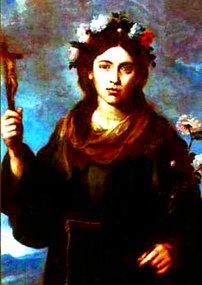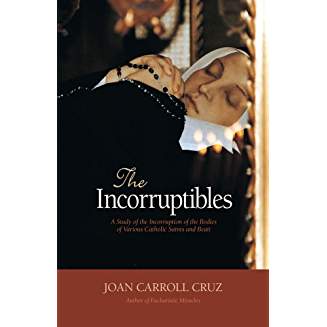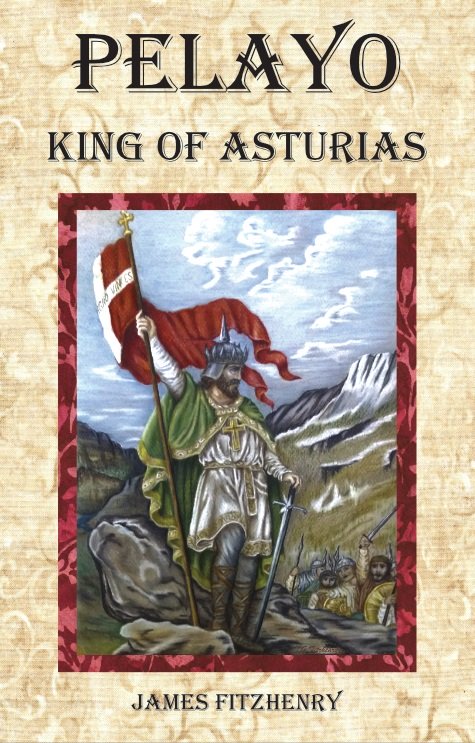
Saint Rose of Viterbo
Saint Rose of Viterbo
Feast Day – September 4
Almighty God did marvelous things in the soul of Saint Rose of Viterbo. It appears that her parents gave her that name by divine inspiration, for it was symbolic of her entire career. As long as she lived, she bloomed like a sweet-scented rose in the garden of the Church, and in full bloom as she was transplanted to Paradise.
Before she was able to speak, Saint Rose attempted to pronounce the sweet names of Jesus and Mary; and as soon as she had learned to walk, she asked to be taken to church and to other retired and quiet places to pray. When religious discourses were given, she would listen with great attention.
When Saint Rose was only 3 years old, God showed how pleased He was with her in a most wonderful way. One of her maternal aunts died. The family were standing around the bier weeping aloud. Deeply moved by the sorrow of her relatives, little Rose went to the coffin, raised her eyes to heaven, and prayed silently. Then she placed her little hand on the body of her deceased aunt and called her by name. The dead woman immediately opened her eyes and reached out to embrace her little niece, who had raised her to life again.
The child entertained a great compassion for the poor; she always tried to save some food to give to the poor. One day when she left the house with some bread in her apron, she met her father, who asked her in curt fashion what she was carrying off now. The frightened child opened her apron and fragrant roses were found in it.
When she was 7 years old, Saint Rose of Viterbo retired to a little cell in her father's house. There she spent almost all her time in contemplation and in practicing rigorous penance. She prayed much for the conversion of sinners. Meanwhile our dear Lord was preparing her for an extraordinary mission.
Saint Rose of Viterbo
St Rose of Viterbo was not yet 10 years old when the Blessed Mother of God instructed her to join the Third Order of St. Francis. Shortly after, our Lord appeared to her on the Cross, wearing the crown of thorns on His head and bleeding profusely from all His wounds.
St Rose, aghast at the sight, called out: "O my Lord, who has reduced Thee to this state?"
Our Lord replied, "My love, my deep love for men has done this."
"But," asked Rose, "who has so pierced and torn Thee?"
"The sins of men have done it," was our Lord's answer. "Sin, sin!" cried the saint, and she scourged herself to make atonement for the sins of the world.
By divine inspiration, Rose then took a cross in her hand and went up and down the streets and public squares of her city telling people of the terrible tortures our Lord suffered and of the heinousness of sin. Every now and then she would emerge from her solitude to entreat the people to do penance.
The town of Viterbo, which belonged to the Papal States, had revolted against the authority of the pope. Disregard for religion and moral degradation were the order of the day. But the sermons of this little missionary had marvelous results. The people came in crowds to hear her. The stone on which she stood was seen to rise in the air, and she was sustained there by a miracle while burning words issued from her lips. The greater part of the citizenry had already resolved to do penance and to return to the legitimate papal allegiance when Saint Rose of Viterbo and her parents were repelled by the civil authorities.
The result was that she now had a wider field of activity. At Soriano and later at Vitorchiano, her preaching had the same blessed results. In the latter place, a sorceress had done much harm among the inhabitants. Fearing that after her departure this woman would undo the good effected there, Rose was desirous of her conversion. Her initial efforts failed. Then our saint had an immense pile of wood prepared in the public square; fire was set to it, and Rose stepped into the fire and mounted to the top of the pile. She remained untouched for three hours in the midst of the flames, singing the praises of God. The sorceress now cast herself at Rose's feet and was sincerely converted.
Meanwhile the rightful authority of the pope had been re-established at Viterbo, and Rose could return. She was now 15 years old and anxious to enter the convent of the Poor Clares. As she had no dowry, she could not be admitted.
"Well," said Rose, "you will not receive me while I am alive, but you will receive me after I am dead." She and several companions repaired to a secluded dwelling, where they intended to live as a community. The ecclesiastical authorities, however, did not approve of the plan, and Rose returned home. She died 2 years later, filled with the joyous desire of being united with her God.

Two and a half years after her death she appeared three times to Pope Alexander IV, who was in Viterbo at the time, and told him to have her body removed to the convent of the Poor Clares. When this was done, her body was found incorrupt; and it has remained in that condition to this day. Miracles are constantly occurring at her tomb. Pope Callistus III canonized her in 1457.
Although her skin is dark, the body of the saint is still flexible and the internal organs in good condition. In 1921 the heart was removed to be placed in a reliquary for a procession, and it was found to be unblemished and perfectly intact at that time.
from: The Franciscan Book Of Saints, ed. by Marion Habig, OFM

Continuously popular since it first appeared in 1977, The Incorruptibles remains the acknowledged classic on the bodies of saints that did not undergo decomposition after death. Many remained fresh and flexible for years, or even centuries. After explaining both natural and artificial mummification, the author shows that the incorruption of the saints' bodies fits neither category but rather constitutes a much greater phenomenon that is unexplained by modern science to this day. The author presents 102 canonized saints, beati, and venerables, summarizing their lives, the discovery of their incorruption, and investigations by Church and medical authorities.
The incorruptible bodies of saints are a consoling sign of Christ s victory over death, a confirmation of the dogma of the Resurrection of the Body, a sign that the Saints are still with us in the Mystical Body of Christ, and proof of the truth of the Catholic Faith—for only in the Catholic Church do we find this phenomenon. Impr. 342 pgs 33 Illus, PB.
Return to Franciscan Calendar Page
Return to Saints Page
Return to Incorruptible Saints Page
Return to Roman Catholic Saints Homepage
NOW AVAILABLE!!
Pelayo's resistance initiated the nearly 800-year-long Reconquista to take back his country from the ruthless invader who had conquered his homeland and sought to erase his culture and his faith. His actions would lay the foundations of a Kingdom for Christ that would eventually reach around the world and spread the Catholic faith to millions of souls. Read more...
Please help us continue to bring high quality books to our readers at the lowest possible price! Click the link below! Thank you!
Now Available!
Defenders of Christendom
Battles - Honor - Miracles!
This book is filled with
amazing stories of little-known
Catholic heroes presenting
spectacles of bravery and
valor never exceeded in all the annals of history.
Demonstrating his
gallantry through daring feats
of arms, the knight's faith,
coupled with his marvelous
courage, made him nearly
invincible on the field
of battle.
read more . . .
Defenders of Christendom is
Learning to Love God
Especially for young children -
Now available as an e-book!
Available for only $2.99 US
as an ebook download.
Also available in Spanish!
The exciting life story of
the holy Catholic knight
known as El Cid!
Available for only
$22.95
The amazing life story of the
little known incorrupt saint
- King Fernando III!
This highly acclaimed book is
inspirational to young men
and a guide to building a strong
masculine, Catholic character!
Also available as softback!








